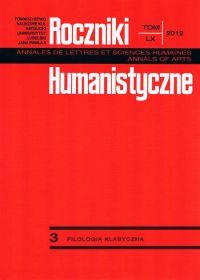Variety of Metres in the Psalm Paraphrase of Caspar Cunradus
Abstract
The author discussed the matter of metre of the Psalm Paraphrase of Caspar Cunradus (1571-1633) from Vratislavia, who belongs to the most popular and highly regarded exponents of Silesian humanist at the turn of the 16th and 17th centuries. Cunradus’ Psalter is a good example of the metrical variety of poetry, which is characterized by using many different metrical measures in the one work. Cunradus used in his Psalter 48 kinds of verses composed in 149 various metrically strophes. His metrical fancies we direct at variety of iambic metres, most frequent are: iambic dimeter catalectic, acatalectic and hipercatalectic. Iambic trimeter also is used by him very often, in a version catalectic, acatalectic and even hipercatalectic. From trochaic measures very frequent are trochaic dimeter catalectic and acatalectic, rare is trochaic trimeter catalectic. From dactylic measures he chooses eagerly Adonian verse, dactylic tripody catalectic (hemiepes) and acatalectic, dimeter catalectic and acatalectic, pentapody (or Greek pantameter), hexameter, rarely elegiac pentameter. Very popular are also Aeolic measures like Sapphic, Alcaic and Phalaecean hendecasyllable. The most often used are pure choriambs, especially glyconic, pherecratean, minor and greater Asclepiad verse. Cunradus also applies mixed dactylic and trochaic metres, named logaedic metres, for example an Aristophan metre, dactylic logaedic pentameter and heptameter, named Archilochian verse and greater Archilochian verse, rarely uses anapests and measures from a minore ionics and galliambic hexameter. Even bigger variety was created thanks to huge number and kinds of metrical orders, which were created from connecting different kinds of mentioned verses and composing them into strophes. He divided strophes according to number of lines in the stanza: two-line strophes (or distichs), three-line strophes (tristichs), four-line strophes (tetrastichs), five-line strophes (pentastichs) and six-line strophes (sexastichs). Each of them come under further distinction according to number of used measures in the strophe: the strophe consisted of one kind of metre (monocolos), the strophe consisted of two kind of metre (dicolos), the strophe consisted of three kind of metre (tricolos), the strophe consisted of four kind of metre (tetracolos). Silesian poet created in this way many new metrical combinations. Only several times on a hundred and fifty Psalms he repeated the same metrical system. Undoubtedly the size of this literary enterprise and his scale must be admired. His Psalm Paraphrase was geared towards a display of erudite skills and a great knowledge of a Latin metrics and a prosody.
References
Cabello Gregorius Martinez CMF: De artis poeticae latinae principiis libri tres. Liber I, De re metrica latina, Matriti: Edit. Coculsa 1945.
Dunn Catherine M.: Scaliger and Metrical Theory, w: Acta Conventus Neo-Latini Amstelodamensis, ed. P. Tuynman, München: Fink 1979, s. 352-357.
Hermann Godofredus: Elementa doctrinae metricae, Lipsiae: Fleischerus 1816.
Green Roger P.H: George Buchanan’s Psalm Paraphrases: Matters of Metre, w: Acta Conventus Neo-Latini Sanctandreani (Fifth international Congress of Neo-Latin Studies, ed. I.D. Mc Farlane, Binghamton, New York 1986, s. 51-60.
Koster W.J.W.: Traité de Métrique Grecque suivi d’un Précis de Métrique Latine, Leyde: A.W. Sijthoff 1953.
Metryka grecka i łacińska, red. M. Dłuska, W. Strzelecki, Wrocław: Zakład Narodowy im. Ossolińskich, 1959.
Michałowska T.: Staropolska teoria genologiczna, Wrocław: Zakład Narodowy im. Ossolińskich 1974.
Modlińska-Piekarz A.: Votum Davidicum, Poetyckie parafrazy psalmów w języku łacińskim w XVI i XVII wieku, Lublin: Towarzystwo Naukowe KUL 2009.
Copyright (c) 2012 Roczniki Humanistyczne

This work is licensed under a Creative Commons Attribution-NonCommercial-NoDerivatives 4.0 International License.





